What is a 3D Printer?
A 3D Printer is a device that enables 3D designs to come to life in front of students' eyes. Typically they use plastic to construct physical versions of virtually created 3D objects. The majority function by heating the plastic so it is soft enough to be squirted through the 3D printers' nozzle. These objects are then literally built from the ground up, layer by layer, until your virtual object has become physical.
Why would I use 3D Printers in the classroom?
3D printing provides many opportunities for students to fully explore the design process as well as providing the means to go deeper in to the content of many subject areas. In its simplest application, students can reproduce objects created by others to engage and make real the content they are studying. However the real power comes from not just 3D printing but 3D design where students can ideate, design, modify and prototype solutions across the curriculum.
Curriculum Connections
There is obvious application for 3D design and printing in the design process within design and technology. In addition, the majority of design projects also require extensive application of mathematical concepts such as measurement, shape and density. When working in a problem based learning (PBL) environment, there is application across the curriculum as 3D Printing allows for rapid prototyping of designed solutions to real world problems.
There are many resources and stories online that discuss how to incorporate 3D Printing in to your classroom. In addition you will find several books to assist with the basics. One to read that incorporates the technical and the pedagogical is 'The Invent to Learn Guide to 3D Printing in the Classroom'.
 Links to Future Focused Learning
Links to Future Focused Learning
3D Printing supports several of the future learning themes, however as a prototyping tool it's forte lies in enabling the experiential classroom. Working with 3D printers involves students in design and rapid prototyping ensuring they are both inspired and equipped to solve real world problems through experimentation, investigation and innovation.
Finding a 3D Printer
Before purchasing a 3D printer we recommend you read the advice from the Design and Technology Curriculum Advisor found in the following issue of Tech Talk. The article outlines the safety precautions you need to be aware of as well as providing purchasing tips and much more.
